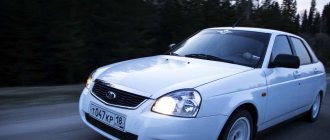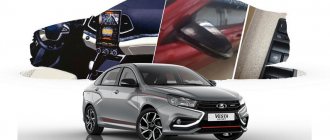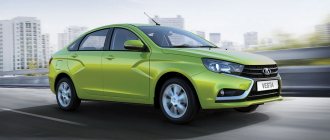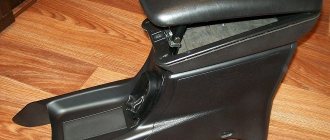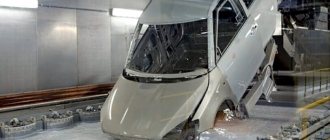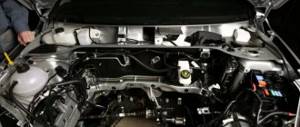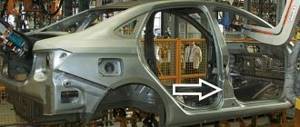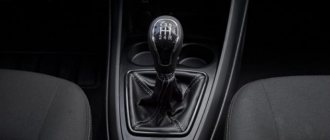The new domestic Lada Vesta sedan attracted the interest of many people who were planning to buy a car. However, when the Lada X-Ray hatchback was released, many were confused as to which was better. Give preference to a familiar and comfortable sedan at a low cost, or still pay more and get a powerful and practical hatchback.
Lada Vesta or Xray, which is better? To answer this question correctly, it is necessary to compare such vehicle parameters as interior, technical characteristics, maneuverability, speed and fuel consumption, equipment and price.
Interior of Lada X-Ray and Lada Vesta
As for the interior decoration of the models, it produces a pleasant effect. The cars look quite impressive, it is worth noting that the similarity of the models is immediately noticeable. The general style of the dashboard, a dashboard with wells, elongated air deflectors, a center console, almost the same steering wheel, comfortable seats, a rear sofa with a harmonious profile.
Salon X Ray
Salon Vesta
In addition, cars have such a positive quality as visibility. The side mirrors are large enough to allow you to clearly see the situation behind you.
Don’t forget that Vesta is a sedan, so there is quite a bit more space in the rear cabin. X Ray wins with his height.
Engine characteristics
As for engines, the Lada X-Ray still has the advantage. The manufacturer offers a choice of 3 engines at once, which cannot be said about the Lada Vesta, since there is no choice here, and only one engine is offered.
If we talk about general features, then for both cars a domestic engine of the VAZ-21129 series is produced. Engine power is 106 horsepower. The unit has a reliable and simple design: 4 cylinders and 16 valves, as well as a distributed fuel injection complex.
- The Lada Vesta can be accelerated to 100 km/h in 11.2 seconds, the X-Ray in 11.4 seconds, despite such a small power.
- As for the maximum speed, the difference is small. X Ray overtakes Vesta by 1 km/h (176 versus 175 km/h).
- Fuel consumption also has a slight difference: Vesta - 9.3/6.9/5.5 liters, X-Ray - 9.3/7.2/5.9 liters.
However, Lada X-Ray can offer its customers several more engines with 110 and 122 horsepower. The first option reaches speeds of up to 184 km/h and has a volume of 1.6 liters. The second one is a little more powerful: the maximum speed here reaches 186 km/h, the volume is 1.8 liters. As for fuel consumption, it is almost the same for both cars.
Related articles:
TTX Lada x Ray
XRAY Cross vs Vesta SW Cross. View from behind the wheel of a double crossover
Is XRAY Cross better than Vesta SW Cross? We listen to the arguments that guided my interlocutor when choosing a new car in LADA showrooms and other dealers.
— When the question arose about buying a new car, among the main contenders, in fact, there were only 2 brands. Moreover, at first the first position was not with LADA. Our family has been successfully using the fifth-generation Passat made in Germany for a long time, so the main contender for some time was its closest relative. But, as they say, measure twice, cut once. A new car is a product that is not purchased often and for a long time.
My previous car was a Peugeot 307 five-door hatchback, and I was never disappointed in this body type. Therefore, there was no particular desire to buy a sedan. Further, the fact that, like LADA, the second contender for purchase was made in the Russian Federation contributed. It was at this moment that I put an equal sign between the cars. Well, then everything was like the girls: appearance, price, equipment. As a result, my car at the end of March this year was the XRAY Cross in “Black Pearl” color.
“Okay, ” I continued, “why not Vesta SW Cross, which, at similar prices, is preferred by eighty percent of buyers?” It is no less attractive, much more spacious, and has several transmission and engine options.
— It’s probably a matter of size. It's too big for me. I have already said that, from my point of view, a hatchback is more practical for urban use. Well, you shouldn’t forget that the XRAY Cross is based on a platform from Renault. In addition, the ground clearance of the XRAY Cross is slightly higher and the bumpers are shorter than those of the Vesta SW Cross.
As for the engine and gearbox, in my case initially it was a 1.8 and a manual transmission. The Peugeot 307 had 2 liters and 137 hp. I didn’t want to deviate too much from these indicators.
XRAY Cross also pleased us with its cheerful interior color combinations. If its entire front panel was dark gray, it’s not a fact that I would choose it. But everything worked out, although we had to wait a few weeks for the car in the maximum configuration.
— In your car, you have a heated steering wheel, cruise control on the steering wheel, the back of the front passenger seat can be folded with a slight movement of the hand, and again there is a glove compartment in the front right seat. How important were these “goodies” when purchasing, and how often do you use them in everyday use?
— When buying, or more precisely, when choosing a car’s configuration, it was more important what this or that version as a whole offers. The Comfort option, although more affordable, did not suit me personally. As a result, the choice fell on Luxe Prestige, which has, if not everything, then almost everything.
As for operation, here I would be the first to mention light and rain sensors, heated seats, and, of course, the Ride Select system. For me, it is one of the main “features” of my car, which greatly adds confidence in the car’s capabilities on forest paths, replete with deep puddles and undulating terrain. Both on the 307 and on the Passat B5 in such places, if there is a detour option, you definitely need to use it, otherwise you can lose your front bumper all at once.
With XRAY Cross everything is different. Move the Ride Select puck to the “Mud” position and off you go. 215 cm of ground clearance and good tires, combined with smart electronics, do their job properly. But there is also a “Sport” mode, which radically changes the car’s response to the gas pedal when you need to drive more actively and faster than usual.
— The trunk of the XRAY Cross is inferior in volume to the cargo space of the Vesta SW Cross, and the same can be said about the space for passengers sitting in the back. Are these XRAY Cross indicators sufficient for your needs?
- More than. What have I not carried in five months. The longest load was a 240 cm long lining, the most voluminous was a children's sleeping mattress. We also had to take old window frames and a small refrigerator from the Soviet past to the dacha. Believe me, the transformation of the interior of this car gives its owner very great opportunities.
Even with full-sized seats for all passengers, XRAY Cross can accommodate several tents, a permanent grill, sleeping bags, rugs and other camping equipment. There were no complaints from rear seat passengers either, although 5 people in a car travel quite often.
— Judging by your story, your car is almost ideal. Is this really true?
- Almost. About three hours after the purchase, while showing off my purchase to friends, I became upset because of the “poker” propping up the open hood. As a result, hydraulic struts were installed on the car on the same day. Then friends advised me to do additional anti-corrosion treatment. By and large - everything.
It was still zero after 4000 km. The procedure is not mandatory, but I decided to do it at an authorized dealer. It’s inexpensive, and it definitely won’t make the engine worse.
Frankly speaking, when purchasing the LADA XRAY Cross in the maximum possible configuration, I wanted to get a car in which nothing needed to be completed, additionally installed, etc. The hood struts and anti-corrosion protection are the few things we had to compromise on. The rest of the car is very good.
I felt the delights of glass with built-in heating already this morning. I haven’t used the heated steering wheel and seats yet, but I’m sure they won’t disappoint me when the cold weather gets more serious. The city fuel consumption (Ai-95) of the car is exactly the same as promised by the factory specifications: 9.7 l/100 km.
The car is new, and you don’t expect any surprises from it that were typical of previous used cars. In addition, despite its generally urban appearance, outside of the asphalt it gives the driver 35-40% more options than a classic passenger car. My experience with XRAY Cross confirms this 100%.
The story of my interlocutor is a clear demonstration that LADA, which relatively recently became a full-fledged part of the Renault Group, is moving in the right direction, and in addition to the Vesta family, the Russian brand has other, no less, and in some respects even more interesting models.
Thanks to the new importer of the brand in the Republic of Belarus, today you can get acquainted with the current LADA model range and test the models you like at the nearest LADA dealership center of the new format, at:
Grodno, st. Belusha, 61/2, t. (+375 152) 33-30-03
LADA.by
Sergey Polyansky
Characteristics of gearboxes
Both cars have identical transmissions. Both models have an AMT-type robotic gearbox and a pair of five-speed manual ones. The only difference here is that Vesta can be equipped with either a domestic or French transmission. X-Ray only has French ones.
In general, the gearboxes operate smoothly, without gear slippage or unpleasant noise. What’s typical is that you won’t find a classic automated gearbox on any model. In order to save money, a robotic gearbox was installed, which affects the ride - more jolts and jerks, a delayed reaction to reverse gear. However, you can get used to it.
STILL GREEN
For a short test ride on the factory oval, the VAZ team rolled out two Xrays. The first one is simpler - with a brand new 114‑horsepower 1.6 H4Mk engine and a JH manual gearbox, the assembly of which was also mastered at AVTOVAZ. Modest equipment, 15‑inch wheels. The second is with the new VAZ-21179 engine (for now it only has a robotic gearbox from Granta), 16‑inch wheels and all the “pies”. Grunenkov sat on the right. We did several laps on one car, then on another... These Xrays are too different! And it's not just about power units. On one, the doors close tighter, on the other, wind noise breaks through the cracks, but the interior plastic grumbles a little less. On the first one, the stabilization system was turned off, and I was pleased with the clear reactions on the reset, but on the other, ESP pulled me back so zealously that I almost knocked the steering wheel out of my hands. Oleg knows all this: “We are also dissatisfied with the level of noise and vibration. But there is still work to be done, using different methods - including modernizing the body welding technology. We will calibrate the ESP. You better pay attention to this: the robot works differently than on Grant.
Equipment and prices of Lada Vesta and Lada X-Ray models
If we consider similar levels of the basic configuration of models, then the Lada X-Ray has a cost more than the Lada Vesta - 589 thousand rubles versus 529. If we look at the top, the prices here also differ: Lada X-Ray - 742 thousand, Lada Vesta - 672 thousand.
If the buyer wants a metallic color, then the additional payment is the same - 10 thousand rubles. However, Vesta offers it for 30 thousand rubles.
As for the configuration of cars, Vesta wins here, since it offers 7 types, X-Ray - only 4.
X-DNA is the basis of a new look
Perhaps the comparison of Lada Vesta and Lada Xray does not look entirely correct, because we can say that these are cars of different classes. Firstly, the first new product is so far presented only in a sedan body and in dimensions corresponds to the B+ segment, and the second is, as they say at AvtoVAZ, a raised B-class hatchback, which, in principle, can easily be considered an ordinary SUV. The only thing that is guaranteed to unite them is the X-style design, which will soon become the new corporate look of all new products from the Volga auto giant.
It must be admitted that both cars look very presentable, stylish and no worse than any other budget car available on the Russian market. Many experts even consider VAZ’s new products to be among the best in terms of design, so it’s quite difficult to compare here, because design has always been a purely individual matter of taste.
As for the overall dimensions, the new sedan:
- longer than the SUV (4410 versus 4165 mm),
- has a larger wheelbase (2635/2592 mm),
- equal to it in body width (1764 mm),
- but noticeably lower (1497/1570 mm).
At the same time, the Xray has a more “roomy” ground clearance - 195 mm versus 171 mm for Vesta, which provides greater freedom when driving on Russian roads, especially in rural areas.
